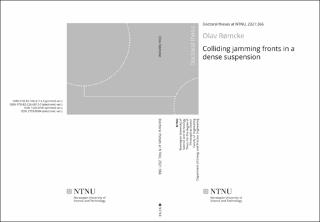| dc.contributor.advisor | Hearst, Jason | |
| dc.contributor.advisor | Peters, Ivo R. | |
| dc.contributor.author | Rømcke, Olav | |
| dc.date.accessioned | 2021-11-09T13:50:41Z | |
| dc.date.available | 2021-11-09T13:50:41Z | |
| dc.date.issued | 2021 | |
| dc.identifier.isbn | 978-82-326-6812-0 | |
| dc.identifier.issn | 2703-8084 | |
| dc.identifier.uri | https://hdl.handle.net/11250/2828708 | |
| dc.description.abstract | Mixtures of liquids and solid particles, known as suspensions, are a quite common material both in natural and industrial processes. For a high concentration of particles, some of these mixtures exhibit a quite remarkable phenomenon whereby they act liquid-like when perturbed lightly, but presents impressive resistance when exposed to an impact or otherwise large stress. In the extreme case, flow is arrested and the material appears solid-like, a phenomenon known as dynamic jamming. The last decade has seen significant progress in our understanding of how the material transitions between these two states. Probably the most famous example of such a material is a cornstarch and water suspension; this stress induced jamming explains how it is possible to stay afloat while running across a cornstarch suspension. The transient development of the solid-like state is observed as fronts of high strain rate propagating through the suspension leaving a jammed state in its wake. Earlier experiments have observed this transition when the sample is subjected to pushing, pulling or shearing, independently, when the shear front is freely propagating or interacting with a solid boundary.
This thesis presents an experimental study of the dynamic jamming phenomenon in dense cornstarch suspensions where two jamming fronts are generated simultaneously for the first time. The experiments are two dimensional and both the velocity field and features of the free surface are used to assess the state of the suspension. We expand upon the previous observations by developing an experimental setup where the flow is visualized for the full field surrounding the perturbing body where pushing, pulling and shearing are observed in a single experiment. By introducing two perturbing bodies, the response of the suspension is investigated as the front collides.
Key accomplishments include the observation of an unjammed pocket in the collision region between the perturbing bodies. Velocity measurements alone do not capture the shape of this pocket. However, it is clearly indicated by the free surface texture. Furthermore, a method is developed which is capable of quantifying the orientation of the features on the free surface. As shown by the literature, a scalar measure of the local accumulated strain of the material is a sufficient measure for the solid-liquid transition as the front propagates unimpeded through the suspension. However, this thesis reveals that both the shape of the unjammed pocket and the orientation of the surface features are closely linked to the direction of principle strain. | en_US |
| dc.language.iso | eng | en_US |
| dc.publisher | NTNU | en_US |
| dc.relation.ispartofseries | Doctoral theses at NTNU;2021:366 | |
| dc.relation.haspart | Paper 1: Rømcke, Olav; Peters, Ivo R.; Hearst, Robert Jason. Getting jammed in all directions: Dynamic shear jamming around a cylinder towed through a dense suspension. Physical Review Fluids 2021 ;Volum 6. https://doi.org/10.1103/PhysRevFluids.6.063301 | en_US |
| dc.relation.haspart | Paper 2: Rømcke, Olav; Peters, Ivo R.; Hearst, Robert Jason. Characterizing the surface texture of a dense suspension undergoing dynamic jamming. Experiments in Fluids 2021 https://doi.org/10.1007/s00348-021-03323-3 This article is licensed under a Creative Commons Attribution 4.0 International License (CC BY 4.0) | en_US |
| dc.relation.haspart | Paper 3: Rømcke, Olav; Peters, Ivo R.; Hearst, Robert Jason. Collision of dynamic jamming fronts in a dense suspension. Physical Review Fluids 2021 ;Volum 6. https://doi.org/10.1103/PhysRevFluids.6.103301
This article is licensed under a Creative Commons Attribution 4.0 International License (CC BY 4.0) | en_US |
| dc.title | Colliding jamming fronts in a dense suspension | en_US |
| dc.type | Doctoral thesis | en_US |
| dc.subject.nsi | VDP::Technology: 500::Environmental engineering: 610 | en_US |
